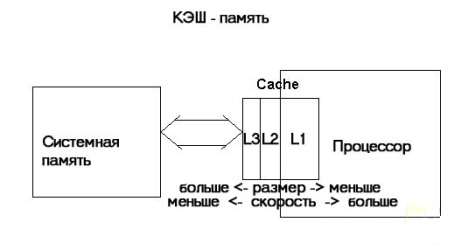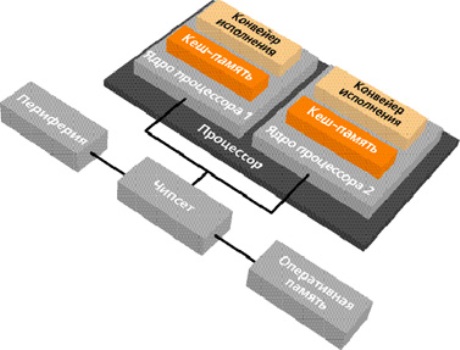The processor is one of the main and important components of modern PCs, laptops, netbooks and tablets designed to perform tasks derived from various programs. More recently, when choosing a processor, buyers first paid attention to the manufacturer and clock speed. This situation has not changed at the present time, however, in addition to choosing one of the two global brands AMD and Intel, you should pay attention to other equally important indicators of processors. So, let's try to answer such an important question -?
At choosing a processor, it is necessary to consider the following main specifications: clock frequency, cache, number of cores, heat dissipation, socket, bus frequency and technical process.
Specifications
Clock frequency

An important indicator that determines the number of operations performed by the processor per unit of time (per 1 second). Clock speed is measured in GHz (gigahertz). For example, a processor with a frequency of 1.8 GHz is capable of processing 1 billion and 800 million operations per second. This means that the higher the frequency, the more powerful processor You'll get. Therefore, we advise you to first focus on this characteristic when choosing.
Cache memory
 The cache is another important technical characteristic of the processor, determining the speed at which the microprocessor accesses the RAM. Cache memory helps improve processor performance by quickly processing necessary data that is loaded from the cache rather than from the computer's RAM.
The cache is another important technical characteristic of the processor, determining the speed at which the microprocessor accesses the RAM. Cache memory helps improve processor performance by quickly processing necessary data that is loaded from the cache rather than from the computer's RAM.
The cache memory can have three levels:
- First level (L1). This is the most First level cache, which has a small size but high speed. The cache memory size can be 8 – 128 KB.
- Second level (L2). This is an average cache level, larger and slower. The cache size is 128 KB - 12.28 MB.
- Third level (L3). This is the last cache level, the slowest and most voluminous. The size of such memory is 0 KB - 16.38 MB. The third cache level may be contained only in certain processor models, or may be completely absent.
 Number of Cores
Number of Cores
Despite the number of cores, some programs run faster with a regular processor. If the development of clock speed has a certain framework, then the number of processor cores increases constantly. What determines the number of cores in a processor? It affects the performance of the PC as a whole, in other words, it shows how many programs can run simultaneously in a certain period of time. However, it is worth remembering that some programs may only target a specific number of cores, meaning that if the processor has 2 cores and the program only uses 1 core, then the other core will not be used. If you are using a PC, laptop, netbook, as well as for work, study, and also for accessing the Internet, in this case 2 nuclear processor quite enough. If you plan to install games on your computer or process large video and photo files, then choose 4-core or higher processors.
Choose processors that are built on modern kernels. They are more optimized and therefore work faster. In addition, they do not heat up and have other advantages.
Heat dissipation
The heat dissipation parameter determines the heating level of the processor in operating condition, as well as the required cooling system. Units of measurement of heat release are W (watts). The heat dissipation rate can range from 10 to 160 W.
Socket

This is a small connector designed to mount the processor in motherboard. Therefore, when choosing a processor, focus on this parameter. It must be identical to the motherboard socket.
Bus frequency
This is a speed indicator that determines the speed of information exchange with the video accelerator, RAM and peripheral equipment. Additionally, you must consider bandwidth, which affects speed. Bus frequency units are GHz (gigahertz).
Technical process
![]()
This parameter shows the dimensions of the semiconductor elements that are part of the internal circuits of the processor. The smaller the transistor connections used in the circuits, the more powerful the processor you will get. Unfortunately, this characteristic is not marked in price lists for ordinary consumers, so it should be clarified separately with a sales consultant.
At choosing a processor It is worth considering not only the main technical characteristics proposed by manufacturers, but also the results of tests conducted by independent experts. For example, identical processors can produce different test results, using various types loads when working with the same programs.
To determine which processor will become the best option just for you, you should decide for what purposes it will be used. 
Processors for work home and office PCs, laptops and netbooks must be equipped with 2 cores and also have a high clock speed. For gaming PCs, you should choose processors that have the most modern architecture, high-performance cache size, good clock speed and a large number of cores.
We sincerely hope that the information we have provided will help you decide on the right purchase!
The internal clock speed at which the chip operates. As noted in this category, command processing is implemented in several stages. Each stage requires several tens and even hundreds of synchronization cycles.
The frequency is determined during testing and is applied to the microprocessor cover. The line of processors is constantly being replenished with new, faster models, and the slowest models are being discontinued. However, there is an upper limit to the internal frequency, determined mainly by technology-related limitations.
The processor's external frequency determines the frequency at which the processor communicates with the external bus and is related to .
If the external processor bus is considered at the bus interface block level, then the data exchange line between and is .
It should be noted that the effective frequency system bus is twice as high if synchronization with the edge and fall of the clock pulses is used for data transmission (for example, for a bus).
Increasing the effective system bus frequency above the processor's external bus frequency is called . Some provide the ability to gradually increase the FSB frequency in 1 MHz steps until the highest FSB is found at which the entire system still works stably. External overclocking has a much greater effect than internal overclocking of the processor, since it increases the speed of communication with the processor.
Processor circuit diagram
Control block- controls the operation of all processor blocks.
Arithmetic logic block- performs arithmetic and logical calculations.
Registers- a block for storing data and intermediate calculation results - the internal RAM of the processor.
Decoding block- converts data into binary system.
Prefetch block- receives a command from a device (keyboard, etc.) and requests instructions from the system memory.
Level 1 cache (or simply cache)- stores frequently used instructions and data.
Level 2 cache- stores frequently used data.
Bus block- serves for input and output of information.
This scheme corresponds to P6 architecture processors. Processors from Pentium Pro to Pentium III were created using this architecture. Pentium 4 processors are manufactured using the new Intel® NetBurst architecture. IN Pentium processors 4 The level 1 cache is divided into two parts - the data cache and the instruction cache.
Processor Specifications
The main characteristics of the processor are its clock speed, bit width and the size of the 1st and 2nd level cache.
Frequency is the number of vibrations per second. Clock speed is the number of clock cycles per second. As applied to the processor:
Clock frequency is the number of operations the processor can perform per second.
Those. The more operations per second a processor can perform, the faster it runs. For example, a processor with a clock frequency of 40 MHz performs 40 million operations per second, with a frequency of 300 MHz - 300 million operations per second, with a frequency of 1 GHz - 1 billion operations per second.
By 2003, processor clock speeds reached 3 GHz.
There are two types of clock speed - internal and external.
Internal clock speed- this is the clock frequency at which work occurs inside the processor.
External clock frequency or system bus frequency- this is the clock frequency at which data is exchanged between the processor and the computer's RAM.
Until 1992, processors had the same internal and external frequencies, and in 1992 Intel company introduced the 80486DX2 processor, in which the internal and external frequencies were different - the internal frequency was 2 times higher than the external one. Two types of such processors were released with frequencies of 25/50 MHz and 33/66 MHz, then Intel released the 80486DX4 processor with triple the internal frequency (33/100 MHz).
Since that time, other manufacturing companies also began to produce processors with double the internal frequency, and IBM began to produce processors with triple the internal frequency (25/75 MHz, 33/100 MHz and 40/120 MHz).
IN modern processors, for example, with a processor clock frequency of 3 GHz, the system bus frequency is 800 MHz.
Processor size determined by the capacity of its registers.
A computer can operate simultaneously with a limited set of pieces of information. This set depends on the bit depth of the internal registers. A digit is a storage unit of information. In one working cycle, a computer can process the amount of information that can fit in the registers. If registers can store 8 units of information, then they are 8-bit, and the processor is 8-bit, if the registers are 16-bit, then the processor is 16-bit, etc. The higher the processor bit capacity, the large quantity it can process information in one clock cycle, which means the faster the processor works.
The Pentium 4 processor is 32-bit.
Level 1 and 2 cache size also affects processor performance.
The Pentium III processor has a 16 KB level 1 cache and a 256 KB level 2 cache.
Pentium 4 processors have an 8 KB L1 data cache, a 12,000-order L1 instruction cache, and a 512 KB L2 instruction cache.
At a time when Cell phones were thick and black and white, processors were single-core, and gigahertz seemed an insurmountable bar (20 years ago), the only characteristic for comparing CPU power was the clock frequency. A decade later the second important characteristic became the number of cores. Nowadays, a smartphone, less than a centimeter thick, contains more cores, and has a higher clock speed than a simple PC of those years. Let's try to figure out what the processor clock speed affects.
The processor frequency affects the speed at which the processor transistors (and there are hundreds of millions of them inside the chip) switch. It is measured in the number of switchings per second and expressed in millions or billions of hertz (megahertz or gigahertz). One hertz is one switching of processor transistors per second, therefore, one gigahertz is one billion such switchings in the same time. In one switch, to put it simply, the core performs one mathematical operation.
Following the usual logic, we can come to the conclusion that the higher the frequency, the faster the transistors in the cores switch, the faster problems are solved. That is why in the past, when the bulk of processors were essentially improved Intel x86, the architectural differences were minimal, and it was clear that the higher the clock frequency, the faster the calculations. But over time, everything changed.
Is it possible to compare frequencies of different processors?
In the 21st century, developers taught their processors to process not just one instruction per clock, but more. Therefore, processors with the same clock frequency, but based on different architectures, produce different levels speed. Intel Core i5 2 GHz and Qualcomm Snapdragon 625 2 GHz are different things. Although the second has more cores, it will be weaker in heavy tasks. Therefore, the frequency of different types of cores cannot be compared; it is also important to take into account specific performance (the number of instruction executions per clock cycle).
If we draw an analogy with cars, then the clock frequency is the speed in km/h, and the specific productivity is the load capacity in kg. If a car (ARM processor for a smartphone) and a dump truck (x86 chip for a PC) are driving nearby, then at the same speed the car will transport a couple of hundred kilos at a time, and the truck will carry several tons. If we talk about different types cores specifically for smartphones (Cortex A53, Cortex A72, Qualcomm Kryo) - these are all passenger cars, but with different capacities. Accordingly, here the difference will not be so huge, but still significant.

You can only compare clock speeds of cores on the same architecture. For example, MediaTek MT6750 and Qualcomm Sanapdragon 625 each contain 8 Cortex A53 cores. But MTK has a frequency of up to 1.5 GHz, and Qualcomm has a frequency of 2 GHz. Consequently, the second processor will work approximately 33% faster. But the Qualcomm Snapdragon 652, although it has a frequency of up to 1.8 GHz, is faster than the 625 model, since it uses more powerful Cortex A72 cores.
What does a high processor frequency do in a smartphone?
As we have already found out, the higher the clock frequency, the faster the processor runs. Consequently, the performance of a smartphone with a higher frequency chipset will be higher. If one smartphone processor contains 4 Kryo cores at 2 GHz, and the second contains 4 of the same Kryo cores at 3 GHz, then the second one will be about 1.5 times faster. This will speed up the launch of applications, reduce startup time, allow heavy sites to be processed more quickly in the browser, etc.
However, when choosing a smartphone with high processor frequencies, you should also remember that the higher they are, the greater the energy consumption. Therefore, if the manufacturer increased more gigahertz, but did not optimize the device properly, it may overheat and go into “throttling” (forced reset of frequencies). For example, the Qualcomm Snapdragon 810 once suffered from such a drawback.

